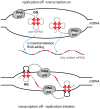Multiple G-quartet structures in pre-edited mRNAs suggest evolutionary driving force for RNA editing in trypanosomes
- PMID: 27436151
- PMCID: PMC4951716
- DOI: 10.1038/srep29810
Multiple G-quartet structures in pre-edited mRNAs suggest evolutionary driving force for RNA editing in trypanosomes
Abstract
Mitochondrial transcript maturation in African trypanosomes requires a U-nucleotide specific RNA editing reaction. In its most extreme form hundreds of U's are inserted into and deleted from primary transcripts to generate functional mRNAs. Unfortunately, both origin and biological role of the process have remained enigmatic. Here we report a so far unrecognized structural feature of pre-edited mRNAs. We demonstrate that the cryptic pre-mRNAs contain numerous clustered G-nt, which fold into G-quadruplex (GQ) structures. We identified 27 GQ's in the different pre-mRNAs and demonstrate a positive correlation between the steady state abundance of guide (g)RNAs and the sequence position of GQ-elements. We postulate that the driving force for selecting G-rich sequences lies in the formation of DNA/RNA hybrid G-quadruplex (HQ) structures between the pre-edited transcripts and the non-template strands of mitochondrial DNA. HQ's are transcription termination/replication initiation sites and thus guarantee an unperturbed replication of the mt-genome. This is of special importance in the insect-stage of the parasite. In the transcription-on state, the identified GQ's require editing as a GQ-resolving activity indicating a link between replication, transcription and RNA editing. We propose that the different processes have coevolved and suggest the parasite life-cycle and the single mitochondrion as evolutionary driving forces.
Figures




Similar articles
-
The RNA chaperone activity of the Trypanosoma brucei editosome raises the dynamic of bound pre-mRNAs.Sci Rep. 2016 Jan 19;6:19309. doi: 10.1038/srep19309. Sci Rep. 2016. PMID: 26782631 Free PMC article.
-
Experimental verification of the secondary structures of guide RNA-pre-mRNA chimaeric molecules in Trypanosoma brucei.Eur J Biochem. 1996 Sep 15;240(3):721-31. doi: 10.1111/j.1432-1033.1996.0721h.x. Eur J Biochem. 1996. PMID: 8856076
-
Knockout of the glutamate dehydrogenase gene in bloodstream Trypanosoma brucei in culture has no effect on editing of mitochondrial mRNAs.Mol Biochem Parasitol. 1999 May 15;100(1):5-17. doi: 10.1016/s0166-6851(99)00024-9. Mol Biochem Parasitol. 1999. PMID: 10376989
-
RNA editing in trypanosomes.Eur J Biochem. 1994 Apr 1;221(1):9-23. doi: 10.1111/j.1432-1033.1994.tb18710.x. Eur J Biochem. 1994. PMID: 7513284 Review.
-
The RNA editing process in Trypanosoma brucei.Semin Cell Biol. 1993 Aug;4(4):251-60. doi: 10.1006/scel.1993.1030. Semin Cell Biol. 1993. PMID: 8241468 Review.
Cited by
-
KRGG1 function in RNA editing in Trypanosoma brucei.RNA. 2023 Feb;29(2):228-240. doi: 10.1261/rna.079418.122. Epub 2022 Nov 18. RNA. 2023. PMID: 36400448 Free PMC article.
-
Separating the Wheat from the Chaff: RNA Editing and Selection of Translatable mRNA in Trypanosome Mitochondria.Pathogens. 2019 Jul 18;8(3):105. doi: 10.3390/pathogens8030105. Pathogens. 2019. PMID: 31323762 Free PMC article. Review.
-
Design, synthesis, and antiprotozoal evaluation of new 2,4-bis[(substituted-aminomethyl)phenyl]quinoline, 1,3-bis[(substituted-aminomethyl)phenyl]isoquinoline and 2,4-bis[(substituted-aminomethyl)phenyl]quinazoline derivatives.J Enzyme Inhib Med Chem. 2020 Dec;35(1):432-459. doi: 10.1080/14756366.2019.1706502. J Enzyme Inhib Med Chem. 2020. PMID: 31899980 Free PMC article.
-
Analysis of DNA Polymerases Reveals Specific Genes Expansion in Leishmania and Trypanosoma spp.Front Cell Infect Microbiol. 2020 Oct 7;10:570493. doi: 10.3389/fcimb.2020.570493. eCollection 2020. Front Cell Infect Microbiol. 2020. PMID: 33117729 Free PMC article.
-
Insight into the epigenetic regulation of gene expression in the bloodstream and procyclic forms of Trypanosoma brucei through the involvement of G-quadruplexes.NAR Genom Bioinform. 2025 Jul 17;7(3):lqaf100. doi: 10.1093/nargab/lqaf100. eCollection 2025 Sep. NAR Genom Bioinform. 2025. PMID: 40677914 Free PMC article.
References
-
- Kennedy P. G. E. Clinical features, diagnosis, and treatment of human African trypanosomiasis (sleeping sickness). Lancet Neurol. 12, 186–194 (2013). - PubMed
-
- Jensen R. E. & Englund P. T. Network news: the replication of kinetoplast DNA. Annu. Rev. Microbiol. 66, 473–491 (2012). - PubMed
-
- Benne R. et al.. Major transcript of the frameshifted coxII gene from trypanosome mitochondria contains four nucleotides that are not encoded in the DNA. Cell 46, 819–826 (1986). - PubMed
-
- Feagin J. E., Abraham J. M. & Stuart K. Extensive editing of the cytochrome c oxidase III transcript in Trypanosoma brucei. Cell 53, 413–422 (1988). - PubMed
Publication types
MeSH terms
Substances
LinkOut - more resources
Full Text Sources
Other Literature Sources
Research Materials

